Recent Mold Remediation Posts
Prevent the Spread of Mold in Your Home
6/30/2020 (Permalink)
Homeowners everywhere will most likely face the horror of spreading mold at some point. You probably won’t escape it, no matter how clean your home is. Black mold can be especially worrisome. If you find it, what should you do to stop it from getting worse?
How Does Mold Spread?
Mold is a type of fungus. It reproduces via microscopic airborne spores which are invisible to the naked eye until they start breeding a colony. So, mold exists wherever there is air and is attracted to moisture. It also thrives in warmer temperatures, usually between 77 and 86 degrees. Mold grows as multicellular filaments called hyphae which give it a fuzzy appearance and emit a distinct musky odor. Spreading mold can cause structural damage to your home if left unchecked. Some common types of mold are:
- Black mold — Stachybotrys chartarum
- Blue/green mold — Penicillium
- Pink mold — Aureobasidium
- Yellow mold — Serpula lacrymans
What Not To Do
If you discover mold damage in your home, do not attempt to remove it yourself. If you do so, you are more likely to contribute to its spread rather than getting rid of it. There are specific steps to follow for the removal of mold, so it’s best to leave this process in professional hands.
What You Should Do
Your home can never be completely free of mold because of its nature as a microscopic airborne particle, but growth can be stopped and removed, and appropriate spore levels can be managed. Your first step is to set up a mold damage assessment. There are many specialists that offer mold remediation processes that include containment, removal of infested materials, air filtration, cleaning of belongings and restoration of the area. These techniques all follow strict protocols and professional standards.
Mold is an especially tough obstacle to overcome for the average homeowner. To avoid accidentally spreading mold and making it worse, don’t be afraid to turn to the experts.
How to Prevent Mold From Spreading
5/23/2019 (Permalink)
 Keep your air conditioning system off to prevent the circulating air from moving spores through the house
Keep your air conditioning system off to prevent the circulating air from moving spores through the house
Things You Should Do if There is a Fungal Growth in Your Home
If you have found black mold in your Orlando, FL home, it is important to remove it as soon as possible, as mold can grow quickly even over short periods of time. If the mold cannot be removed immediately, you should take steps to prevent it from spreading throughout the house. Here are a few things you should do if there is a fungal growth in your home.
1. Keep Everything Dry
In many cases, mold grows as a result of a moisture problem in the home. This can come from leaky pipes and faucets or high levels of humidity. Reducing the moisture in your house can help keep mold from spreading further. Be sure to dry showers and sinks after use and repair any leaks as soon as you can. Opening windows or using exhaust fans while cooking or showering can help lower humidity levels.
2. Turn Off Air Conditioners or Heaters
If the black mold growth has become severe and you notice mold in multiple areas of the home, you may have mold spores traveling through the air. In order to minimize the spreading of mold, you should reduce airflow in the building. Keep your heating, ventilation and air conditioning system turned off to prevent the circulating air from moving spores through the house.
3. Call a Remediation Service
The best way to prevent the spreading of black mold and remove it from your home is to call a mold remediation specialist. These professionals will have the necessary experience and expertise to locate the source of the mold growth and remove it. They can perform cleanup to restore any damaged belongings as well.
If you have noticed a growth, you should have mold cleanup performed as soon as possible. Taking steps to prevent it from spreading will help the remediation process go more quickly and easily. If you are unable to remove the mold on your own, a professional service can do so for you.
How Do I Get Rid of the Mildew on My Plants?
3/29/2019 (Permalink)
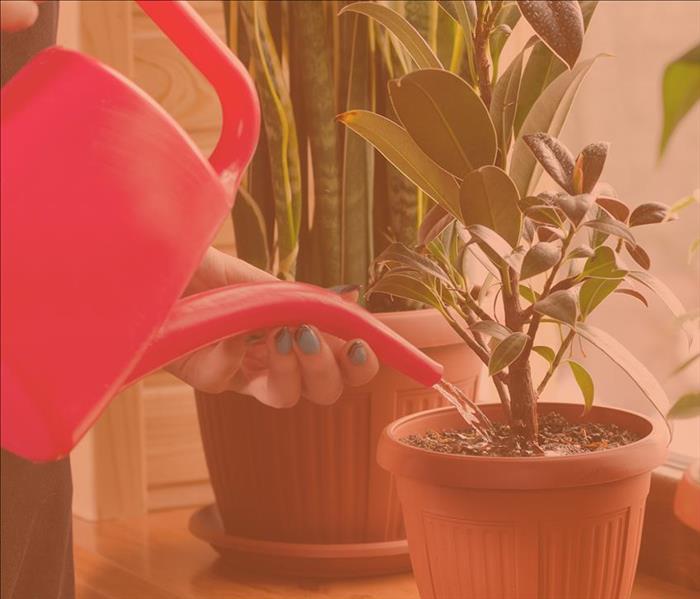 Watering your plants more is another easy solution for powdery mildew
Watering your plants more is another easy solution for powdery mildew
Whether flowering or fruit bearing, bushy or prickly, plants can clear the air and generally bring personality to our homes. But when plant mildew takes hold, you may worry your plant’s days may be numbered. Fortunately, getting mildew doesn’t have to spell the end for your plant. With a little effort and some things you can likely found around your Orlando, FL, home, you can rid your plants of mildew in no time.
About Powdery Mildew
One of the most common fungi to show up on plants is called powdery mildew. It can look a bit like a fine powder you can simply dust off. But it comes back again and again, coating leaves and giving your plant a dull look. Powdery mildew often
- Looks like white or gray spots
- Prefers warm, dry environments
- Shows up when plant foliage is dry
While mildew growth won’t immediately kill your plant, it’s a good idea to clear it before it gets out of hand and becomes a real threat
Cleaning Powdery Mildew
Common grocery store items are your first weapon against plant mildew. Baking soda mixed with liquid soap and water sprayed on plants can neutralize mildew and be a preventative for new mildew formation, while spraying plain mouthwash on leaves can kill mildew spores. Milk offers a surprising antiseptic effect on powdery mildew. Mix one part to three parts of water and rub on leaves to relieve your plants from fungal effects.
Watering your plants more is another easy solution for powdery mildew, erasing the dry environment the fungus loves.
Plant mildew is an unsightly menace that, if left alone, can eventually leach nutrients from your plants and cause them to wither. Look in your cabinet for tools to eradicate it or, in serious cases, talk to a mold specialist to learn about fungicides and other options to keep your plants at their beautiful best.
How to Keep Mold and Moisture Out of Your HVAC System
10/25/2018 (Permalink)
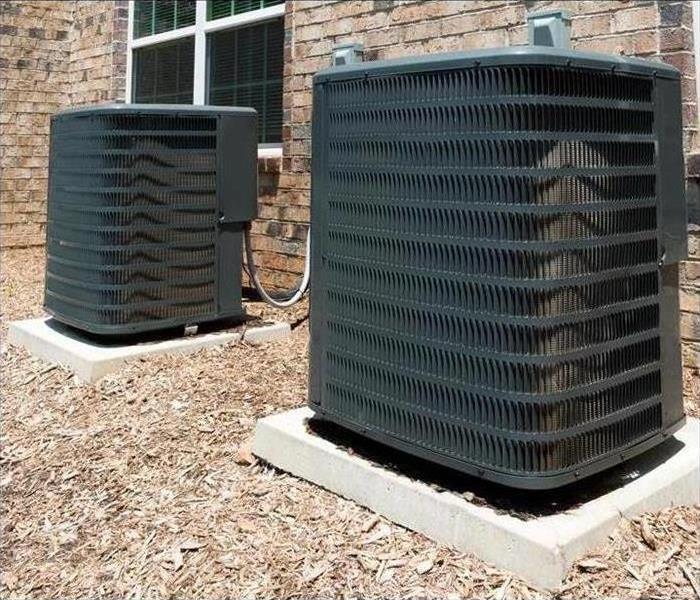 Contact us to remediate your Orlando home!
Contact us to remediate your Orlando home!
Tips and Tricks From SERVPRO of SW Orlando to Keeping Mold and Moisture Out Of Your HVAC System
In the warm summer heat, it's easy to build up moisture; especially when it gets sticky, muggy and humid. When this happens, you naturally crank the A.C., reach for something cold, and kick back in your lazy chair. The problem is, when you're relaxing and enjoying the nice cold breeze, mold is spreading through your ducts, vents, and HVAC system, leaving a nasty haze of mold that you can smell all over the house. If you're running a business, your customers could smell it too- which is why you should always call our service professionals to deal with the problem as soon as possible.
How Does Mold Get in The HVAC System?
Mold damage in Orlando is no laughing matter. Mold, fungus, and other bacteria are in their perfect environment when they're trapped in your HVAC system. It's dark, warm, moist, closed in, and humid, meaning that spores can grow practically unabated. You'll notice more and more scent as heat and humidity is generated from outside and pulled through your ducts.
When this moist air gets in your air system, it collects within and above your HVAC units. At this point, the spores of mold and other fungi easily rise through the air, setting up colonies as your condenser forces them up through the duct system. These aren't the only cases of mold that we've seen at SERVPRO; we've seen mold stick to people's clothes or shoes, and it's all brought inside by excess humidity caused by rainfall.
Here Are a Few Tips on How to Remove Mold From Your HVAC System
1. Continue to clean and maintain your HVAC system, even when you aren't using it. Check the ducts for wet spots, and regularly check and maintain your HVAC filter.
2. Double check the drainage systems on your HVAC for mold. Allow for "dry-out" areas where the drainage comes out to prevent excess moisture.
3. Get dehumidifiers for your home. They are ideal for collecting excess humidity, and they help with the temperature inside your house, too.
4. Always insulate your pipes, walls, and ceilings. Use caulking for cracks to control cracks and leaks.
5. Contrary to common beliefs, keep your windows closed when it's hot outside. Humidity, dust, and dampness easily travel inside.
What Can You Do to Fix Moldy Clothes?
10/19/2018 (Permalink)
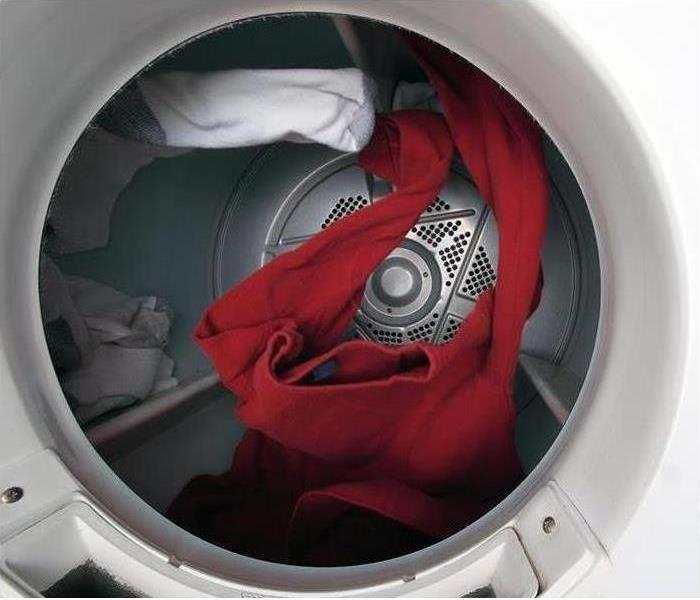 Your dryer is your friend.
Your dryer is your friend.
The reason clothing is so susceptible to mold growth is not just because of the mold-inviting circumstances within the laundry room. Generally, when it is worn, clothing collects sweat and skin cells, as well as dirt and other forms of moisture and organic material that mold loves to feast on. Then, it is placed in the laundry hamper and usually sits for days before it it is finally washed. This scenario is typical and may not result in a noticeable mold infestation, but should the soiled laundry be allowed to fester long enough, a mildew smell may be present, as well as visible signs of green, blue, gray, black, or sometimes even white mold on clothes.
Another scenario is becoming more common due to busy lifestyles and poor habits. The quick development of mold on clothes after washing may be surprising to some, but it is quite an ordinary occurrence for those with overwhelmed schedules or those who are vulnerable to procrastination because they often forget to remove clothing from the washing machine once the cycle is finished. As time passes, this leads to the rapid proliferation of mildew and mold on clothes after washing, due to the remaining moisture. Neglecting to put the wet clothes in the dryer for a few hours is not what makes mold grow. Neglecting the clothes in the washer for 6 hours or longer–sometimes a day or even a few days–is the problem. Before too long, a mildew smell will be detected in the washer and clothing. Some assume this is the residue of soap, and while that may be true to some extent, the fact of the matter is that most soaps contains lard and other organic (even synthetic) materials that mold can thrive off of. The smell is not necessarily the residue of soap, but an indication that mold is producing a secondary metabolite–the mildew smell–from consuming that soap.
What is a natural detergent to kill mold? Here is what you will need.
- Two 5 oz. organic castile soap bars (naturally-scented with lavender or peppermint is great but non-scented works just the same)
- 3 cups of washing soda (no, it’s not the same as baking soda)
- 2 cups of borax
- 30 drops of certified-pure lavender essential oil (optional but highly advisable for a mold killing laundry detergent)
Once you have all the materials, this is what to do.
- Cut the castile soap bars into small pieces or chunks. (This is crucial to avoid damaging the food processor.)
- Place the cut castile soap pieces or chunks in the food processor bowl. Pulse the soap on high until what remains are large crumbs.
- Add the washing soda to the food processor and pulse for 1 minute. (After pulsing, all the ingredients should be in powder form and well-combined. If not, try running the food processor again and then mixing with a spoon.)
- Empty the washing soda and castile soap into the storage container. Add the borax and blend well with a spoon.
- Add the essential oils of choice (optional but beneficial) and be sure to mix well.
Do not place this mixture into the drawer or dispenser, place it directly in with the laundry.
Is Mold Covered by Your Homeowners Insurance?
10/5/2018 (Permalink)
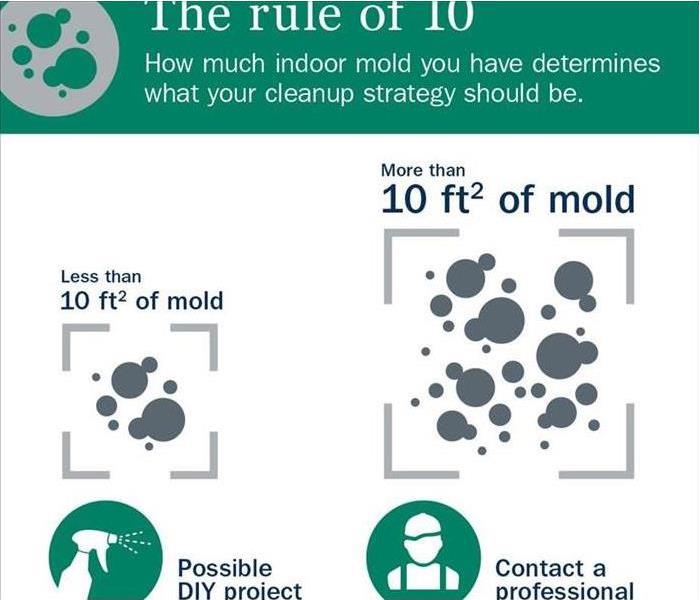 Call SERVPRO of SW Orlando today with any questions about mold, 407-704-0327.
Call SERVPRO of SW Orlando today with any questions about mold, 407-704-0327.
Most owners insurance comes down to the source of the moisture to where the mold damage started. If you are unsure if your homeowners insurance covers mold, go over your policy. Make sure you look for mold exclusions or limitations and call your agent if it still unclear.
If mold results from a sudden and accidental damage, like a pipe bursting, the cost of mold remediation would be covered. Now, if it mold shows up because of neglecting home maintenance then most claims would be rejected.
Here is sample of damage done by an inch of flood water:
- Replace carpet, flooring: $2,700
- New baseboard molding: $2,250
- Replace drywall $1,350
- Cleanup, materials: $1,000
- Bookshelves, lamps: $500
- Total: $7,800
Source: National Flood Insurance Program - https://www.fema.gov/national-flood-insurance-program
You could also buy a mold rider as an add-on to your existing policy for extra coverage. If your insurance carrier doesn’t provide a rider, specialty companies might sell you a stand alone mold policy. Just to warn you, there will be a big price tag for that route.
If your insurance does not cover mold at all, moisture prevention is the key.
To help prevent mold growth, take the following steps:
- Lower indoor humidity with air conditioners, de-humidifiers, and exhaust fans
- Inspect hoses and fittings on appliances, sinks, and toilets
- Use household cleaners with mold-killing ingredients like bleach
- Opt for paints and primes that contain mold inhibitors
- Clean gutters to avoid overflow and check roof for leaks
- Avoid carpet in wet areas like basements and bathrooms
- Remove and dry carpet, padding, and upholstery within 48 hours of flooding
Source: House logic https://www.houselogic.com/finances-taxes/home-insurance/homeowners-insurance-mold-covered/
Mold Remediation Process
10/5/2018 (Permalink)
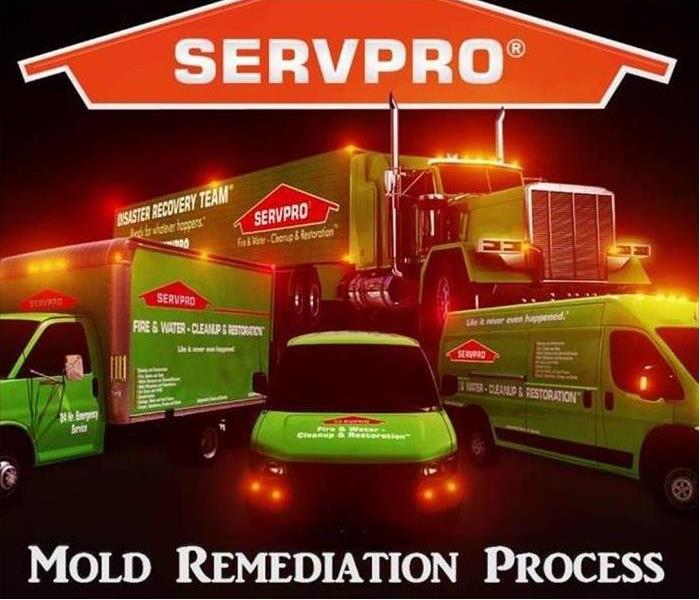 Call SW Orlando SERVPRO today if you have any mold issues. 407-704-0327
Call SW Orlando SERVPRO today if you have any mold issues. 407-704-0327
Mold Remediation Process
Every mold damage scenario is different and requires a unique solution, but the general mold remediation process stays the same. The steps listed below illustrate the “typical” process:
• The mold cleanup and restoration process begins when you call SERVPRO of SW Orlando (407)704—0327. Our representative will ask a series of questions to help us determine the necessary equipment, resources, and personnel.
•SERVPRO Franchise Professionals will carefully inspect your property for visible signs of mold. Mold feeds on cellulose and water and can be hidden from plain view. They use various technologies to detect mold and hidden water sources.
•They use various containment procedures to prevent the spread of mold. They may use advanced containment procedures like negative air chambers to isolate the contaminated area with physical barriers and negative air pressure to keep the mold spores from spreading during the cleanup process. All fans and heating and cooling systems will be turned off to prevent the spread of mold.
• Their specialized filtration equipment allows their Professionals to capture microscopic mold spores out of the air. They utilize powerful “air scrubbers” and HEPA vacuums to prevent the spread of these mold spores while the mold remediation is in process.
• The mold remediation process depends on the amount of mold growth and the types of surfaces on which the mold appears. SERVPRO of SW Orlando uses anti-fungal and antimicrobial treatments to eliminate mold colonies and to help prevent new colonies from forming. Removing and disposing of mold-infested porous materials, like drywall and carpeting, may be necessary to remediate heavy mold growth.
•SERVPRO of SW Orlando will clean your furniture, decorative items, curtains, clothing, and other restorable items affected by mold. They use a variety of cleaning techniques to clean and sanitize your belongings. They’re also trained to remove odors and deodorization using fogging equipment.
•Depending on the level of mold damage, drywall, subfloors, and other building materials may be removed. Restoration may involve minor repairs, such as replacing drywall, painting, and installing new carpet; or it may entail major repairs such as the reconstruction of various areas or rooms in a home or busines





 24/7 Emergency Service
24/7 Emergency Service





